Mercury, Venus, Earth, and Mars are terrestrial (rocky) planets. Among these, Mercury is an extreme: the smallest, the densest (after correcting for self-compression), the one with the oldest surface, the one with the largest daily variations in surface temperature, and the least explored. Understanding this "end member" among the terrestrial planets is crucial to developing a better understanding of how the planets in our Solar System formed and evolved. To develop this understanding, the MESSENGER mission, spacecraft, and science instruments focused on answering six key outstanding questions that allow us to understand Mercury as a planet. For additional, detailed information about the driving science questions and discoveries of the MESSENGER mission, check out some of the articles given on the MESSENGER publication list.
Question 1: Why is Mercury so dense?
Mercury's density implies that a metal-rich core occupies at least 60% of the planet's mass, a figure twice as great as for Earth! MESSENGER acquired compositional and mineralogical information to distinguish among the current theories for why Mercury is so dense.
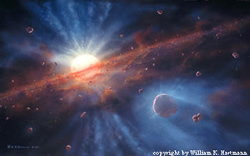
This artist's depiction of the early solar nebula shows the time when the terrestrial planets were forming. Processes such as nebular gas drag, vaporization in the hot early nebula, and giant impacting collisions have all been suggested as possible processes that significantly affected the bulk composition of Mercury. (Painting copyright by William K. Hartmann)
Each of the terrestrial planets consists of a dense iron-rich core surrounded by a rocky mantle, composed largely of magnesium and iron silicates. The topmost layer of rock, the crust, formed from minerals with lower melting points than those in the underlying mantle, either during differentiation early in the planet's history or by later volcanic or magmatic activity. The density of each planet provides information about the relative sizes of the iron-rich core and the rocky mantle and crust, since the metallic core is much denser than the rocky components. Mercury's uncompressed density (what its density would be without compaction of its interior by the planet's own gravity) is about 5.3 grams per cubic centimeter, by far the highest of all the terrestrial planets. In fact, Mercury's density implies that at least 60% of the planet is a metal-rich core, a figure twice as great as for Earth, Venus, or Mars! To account for about 60% of the planet's mass, the radius of Mercury's core must be approximately 75 of the radius of the entire planet!
There are three major theories to explain why Mercury is so much denser and more metal-rich than Earth, Venus, and Mars. Each theory predicts a different composition for the rocks on Mercury's surface. According to one idea, before Mercury formed, drag by solar nebular gas near the Sun mechanically sorted silicate and metal grains, with the lighter silicate particles preferentially slowed and lost to the Sun; Mercury later formed from material in this region and is consequently enriched in metal. This process doesn't predict any change in the composition of the silicate minerals making up the rocky portion of the planet, just the relative amounts of metal and rock. In another theory, tremendous heat in the early nebula vaporized part of the outer rock layer of proto-Mercury and left the planet strongly depleted in volatile elements. This idea predicts a rock composition poor in easily evaporated elements such as sodium and potassium. The third idea is that a giant impact, after proto-Mercury had formed and differentiated, stripped off the primordial crust and upper mantle. This idea predicts that the present-day surface is made of rocks highly depleted in those elements that would have been concentrated in the crust, such as aluminum and calcium.
MESSENGER will determine which of these ideas is correct by measuring the composition of the rocky surface. X-ray, gamma-ray, and neutron spectrometers will measure the elements present in the surface rocks and determine if volatile elements are depleted or if elements that tend to be concentrated in planetary crusts are deficient. A visible-infrared spectrograph will determine which minerals are present and will permit the construction of mineralogical maps of the surface. Analysis of gravity and topography measurements will provide estimates of the thickness of Mercury's crust. To make these challenging, measurements of Mercury's surface composition and crustal characteristics, these instruments will need to accumulate many observations of the surface. MESSENGER's three Mercury flybys provided opportunities to make preliminary observations, but numerous measurements from an orbit around Mercury are needed to determine accurately the surface composition. Once in orbit, these measurements will enable MESSENGER to distinguish among the different proposed origins for Mercury's high density and, by doing so, gain insight into how the planet formed and evolved.
Question 2: What is the geologic history of Mercury?
Before the MESSENGER mission, only 45% of the surface of Mercury had been photographed by a spacecraft! Using its full suite of instruments, MESSENGER investigated the geologic history of Mercury in great detail, including the portions of the planet never seen by Mariner 10.
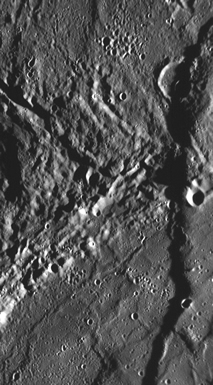
A portion of the long, lobate scarp named Beagle Rupes (right side of this image) deforms an impact crater seen in the upper right. This image was taken during MESSENGER's first flyby of Mercury, and the width of the image is about 110 km.
Prior to MESSENGER, only 45% of Mercury's surface had been seen by spacecraft during the Mariner 10 mission. Combining the Mariner 10 photos with the images from MESSENGER's three Mercury flybys, about 98% of the surface of Mercury has been seen in detail. It is possible for the first time to begin to investigate Mercury's geologic history on a global basis.
Much of Mercury's surface appears cratered and ancient, with a resemblance to the surface of Earth's Moon. Slightly younger, less cratered plains sit within and between the largest old craters. Many of these plains are volcanic, on the basis of their age relative to nearby large impact features and other indicators of volcanic activity. Data from MESSENGER's flybys indicate that volcanism on Mercury persisted for at least the first half of the planet's history, and that the style of volcanism included both effusive and explosive eruptions.
Mercury's tectonic history is unlike that of any other terrestrial planet. On the surface of Mercury, the most prominent features produced by tectonic forces are long, rounded, lobate scarps or cliffs, some over a kilometer in height and hundreds of kilometers in length. These giant scarps are believed to have formed as Mercury cooled and the entire planet contracted on a global scale. Understanding the formation of these scarps thus provides the potential to gain insight into the thermal history and interior structure of Mercury.
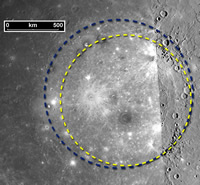
Caloris basin is the best-preserved large impact basin known on Mercury. The full extent of Caloris basin was imaged for the first time during MESSENGER's first flyby of Mercury, revealing that the basin is even larger than previously thought (yellow line = Mariner 10 diameter of 1300 km; blue line = MESSENGER diameter of 1550 km).
Once in orbit, MESSENGER will bring a variety of investigations to bear on Mercury's geology in order to determine the sequence of processes that have shaped the surface. The X-ray, gamma-ray, and visible-infrared spectrometers will determine the elemental and mineralogical makeup of rock units composing the surface. The cameras will image Mercury's surface in color and at a typical imaging resolution that surpasses that of most Mariner 10 pictures. Nearly all of the surface will be imaged in stereo to determine the planet's global topographic variations and landforms; the laser altimeter will measure the topography of surface features even more precisely in the northern hemisphere. Comparing the topography with the planet's gravity field, measured by tracking the MESSENGER spacecraft, will allow determinations of local variations in the thickness of Mercury's crust. This diversity of high-resolution data returned by MESSENGER will enable the reconstruction of the geologic history of Mercury.
Question 3: What is the nature of Mercury's magnetic field?
Mercury has a global internal magnetic field, as does Earth, but Mars and Venus do not. By characterizing Mercury's magnetic field, MESSENGER helped answer the question of how the inner planets differ in their magnetic histories.

The different components of Mercury's magnetosphere result from the complex and dynamic interactions between Mercury's magnetic field and the solar wind. Figure courtesy of J. A. Slavin, NASA Goddard Space Flight Center.
Mercury's magnetic field and the resulting magnetosphere, produced by the interaction of Mercury's magnetic field with the solar wind, are unique in many ways. Perhaps one of the most noteworthy observations about Mercury's magnetic field is the simple observation that the small planet has one. Mercury's magnetic field is similar in its "dipole" shape to Earth's magnetic field, which resembles the field that would be produced if there was a giant bar magnet at the center of the planet. In contrast, Venus, Mars, and the Moon do not show evidence for intrinsic dipolar magnetic fields, but the Moon and Mars have evidence for local magnetic fields centered on different rock deposits.
Earth's magnetosphere is very dynamic and constantly changing in response to activity of the Sun, including both solar storms and more modest changes in the solar wind and interplanetary magnetic field. We see the effects of these dynamics on the ground as they affect power grids and electronics, causing blackouts and interference with radios and telephones. Mercury's magnetosphere was shown by Mariner 10 to experience similar dynamics; understanding those variations will help us to understand the interaction of the Sun with planetary magnetospheres in general.
Although Mercury's magnetic field is thought to be a miniature version of Earth's, Mariner 10 didn't measure Mercury's field well enough to characterize it. There is even considerable uncertainty in the strength and source of the magnetic field. MESSENGER's Mercury flybys confirmed that there is a global magnetic field on Mercury, most likely arising from fluid motions in an outer liquid portion of Mercury's metal core, but there is uncertainty about the molten fraction of the core as well as whether the field is driven by compositional or thermal differences. However, the different ideas for the driving force behind Mercury's magnetic field predict slightly different field geometries, so careful measurements by spacecraft can potentially distinguish among current theories.
MESSENGER's magnetometer will characterize Mercury's magnetic field in detail from orbit over four Mercury years (each Mercury year equals 88 Earth days) to determine its precise strength and how that strength varies with position and altitude. The effects of the Sun on magnetosphere dynamics will be measured by the magnetometer and by the energetic particle and plasma spectrometer. MESSENGER's highly capable instruments and broad orbital coverage will greatly advance our understanding of both the origin of Mercury's magnetic field and the nature of its interaction with the solar wind.
Question 4: What is the structure of Mercury's core?
Through a combination of measurements of Mercury's gravity field and observations by the laser altimeter, MESSENGER determined the size of Mercury's core and verified that Mercury's outer core is molten.
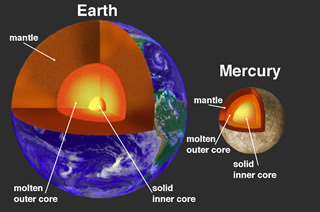
The radius of the core of Mercury is approximately 75% of that of the entire planet, which is a much larger fraction of the planet than for Earth. Like Earth, Mercury has a core that is at least partially liquid. However, unlike Earth, the size of the solid inner core is not known. Figure courtesy of NASA and APL.
As discussed for Questions 1 and 3, Mercury has a very large iron-rich core and a global magnetic field; this information was first gathered by the Mariner 10 flybys. More recently, Earth-based radar observations of Mercury have also determined that at least a portion of the large metal core is still liquid. Having at least a partially molten core means that a very small but detectable variation in the spin rate of Mercury has a larger amplitude because of decoupling between the solid mantle and the liquid core. Knowing that the core has not completely solidified, even as Mercury has cooled over billions of years since its formation, places important constraints on the planet's thermal history, evolution, and core composition.
However, these constraints are limited because of the low precision of current information on Mercury's gravity field from the Mariner 10 and MESSENGER flybys. Fundamental questions about Mercury's core remain to be explored, such as its composition. A core of pure iron would be completely solid today, due to the high melting point of iron. However, if other elements, such as sulfur, are also present in Mercury's core, even at a level of only a few percent, the melting point is lowered considerably, allowing Mercury's core to remain at least partially molten as the planet cooled. Constraining the composition of the core is intimately tied to understanding what fraction of the core is liquid and what fraction has solidified. Is there just a very thin layer of liquid over a mostly solid core or is the core completely molten? Addressing questions such as these can also provide insight into the current thermal state of Mercury's interior, which is very valuable information for determining the evolution of the planet.
Using the laser altimeter in orbit, MESSENGER will verify the presence of a liquid outer core by measuring Mercury's libration. Libration is the slow, 88-day wobble of the planet about its rotational axis. The libration of the rocky outer part of the planet will be twice as large if it is floating on a liquid outer core than if it is frozen to a solid core. By radio tracking of the spacecraft in orbit, MESSENGER will also determine the gravity field with much better precision than can be accomplished during flybys. The libration experiment, when combined with improved measurements of the gravity field, will provide information on the size and structure of the core.
Question 5: What are the unusual materials at Mercury's poles?
At Mercury's poles, some crater interiors have permanently shadowed areas that contain highly reflective material at radar wavelengths. Could this material be ice, even though Mercury is the closest planet to the Sun? Find out what MESSENGER discovered.
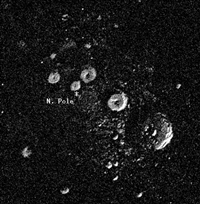
A radar image of the north polar region of Mercury shows radar-bright regions concentrated in circular floors of craters with permanently shadowed interiors. The radar-bright material might be water ice, but alternative suggestions have also been proposed. The image is 450 km across. Image courtesy of J. K. Harmon, Arecibo Observatory.
Mercury's axis of rotation is oriented nearly perpendicular to the planet's orbit, so that in polar regions sunlight strikes the surface at a near-constant grazing angle. Some of the interiors of large craters at the poles are thus permanently shadowed and perpetually very cold. Earth-based radar images of the polar regions show that the floors of large craters are highly reflective at radar wavelengths, unlike the surrounding terrain. Furthermore, the radar-bright regions are consistent in their radar properties with the polar cap of Mars or the icy moons of Jupiter, suggesting that the material concentrated in the shadowed craters is water ice. The idea of water ice being stable on the surface of the planet closest to the Sun is intriguing.
The temperature inside these permanently shadowed craters is believed to be low enough to allow water ice to be stable for the majority of the observed deposits. Ice from infalling comets and meteoroids could be cold-trapped in Mercury's polar deposits over millions to billions of years, or water vapor might outgas from the planet's interior and freeze at the poles. A few craters at latitudes as low as 72° N have also been observed to contain radar-bright material in their interiors, and at these warmer latitudes maintaining stable water ice for longer periods of time may be more difficult; a recent comet impact, in the last few million years, may be required to satisfy all radar observations. Alternatively, it has been suggested that the radar-bright deposits are not water ice but rather consist of a different material, such as sulfur. Sulfur would be stable in the cold traps of the permanently shadowed crater interiors, and the source of sulfur could be either be infalling meteoritic material or the surface of Mercury itself. It has also been proposed that the naturally occurring silicates that make up the surface of Mercury could produce the observed radar reflections when maintained at the extremely low temperatures present in the permanently shadowed craters.
MESSENGER's three flybys of Mercury passed nearly over the equator and did not allow for viewing of the planet's poles. Once in orbit around Mercury, however, MESSENGER's neutron spectrometer will search for hydrogen in any polar deposits, the detection of which would suggest that the polar deposits are water-rich. The ultraviolet spectrometer and energetic particle and plasma spectrometer will search for the signatures of hydroxide or sulfur in the tenuous vapor over the deposits. The laser altimeter will provide information about the topography of the permanently shadowed craters. Understanding the composition of Mercury's polar deposits will clarify the inventory and availability of volatile materials in the inner Solar System.
Question 6: What volatiles are important at Mercury?
MESSENGER measured the composition of Mercury's thin exosphere, providing insights into the processes that are responsible for its existence.
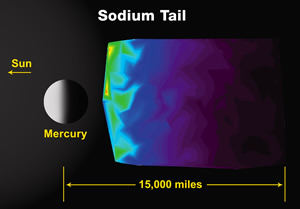
During MESSENGER's first flyby of Mercury, the distribution of neutral sodium in the "tail" of Mercury's exosphere was measured.
Mercury is surrounded by an extremely thin envelope of gas. It is so thin that, unlike the atmospheres of Venus, Earth, and Mars, the molecules surrounding Mercury don't collide with each other and instead bounce from place to place on the surface like many rubber balls. This tenuous atmosphere is called an "exosphere."
Seven elements are known to exist in Mercury's exosphere: hydrogen, helium, oxygen, sodium, potassium, calcium, and, as discovered by MESSENGER, magnesium. The observed exosphere is not stable on timescales comparable to the age of Mercury, and so there must be sources for each of these elements. High abundances of hydrogen and helium are present in the solar wind, the stream of hot, ionized gas emitted by the Sun. The other elements are likely from material impacting Mercury, such as micrometeoroids or comets, or directly from Mercury's surface rocks. Several different processes may have put these elements into the exosphere, and each process yields a different mix of the elements: vaporization of rocks by impacts, evaporation of elements from surface rocks in sunlight, sputtering by solar wind or magnetospheric ions, or diffusion from the planet's interior. Strong variability in the composition of Mercury's exosphere has been observed, suggesting an interaction of several of these processes.
MESSENGER will determine the composition of Mercury's exosphere using its ultraviolet spectrometer and energetic particle and plasma spectrometer. The exosphere composition measured by these instruments will be compared with the composition of surface rocks measured by the X-ray, gamma-ray, and neutron spectrometers. As MESSENGER orbits Mercury, variations in the exosphere's composition will be monitored. The combination of these measurements will elucidate the nature of Mercury's exosphere and the processes that contribute to it.